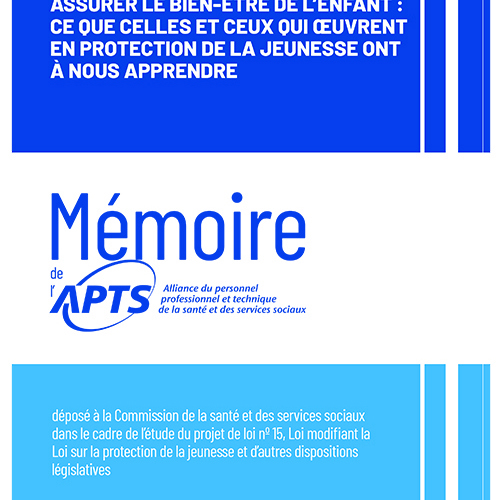
The APTS represents the overwhelming majority of workers providing youth services. For years, spokespersons for these 10,000 employees have been denouncing their work overload and the poor management practices that make it extraordinarily difficult for them to carry out their mission. In May 2020, the APTS spoke out on behalf of youth workers before the special commission on the rights of children and youth protection.
Our recommendations
Our recommendations were developed through extensive consultations with over 60 front-line and second-line workers from most regions across Québec. The recommendations focus on the organization and funding of services, employees’ conditions of practice, the legislative framework, and how the courts work. Here are the key points.
Organization and funding of services
Instead of solving the existing problems in the health and social services system, administrative reorganizations have made them worse and even created new ones by excessively centralizing the decision-making processes. Institutional mergers were supposed to provide greater continuity of services by making youth centres part of large, integrated centres. Instead, specialized resources have been dispersed, various spaces for youth workers to confer together have been dismantled, and families’ access to services has been reduced. Our recommendations are designed to mitigate these setbacks.
Difficulties in gaining access to services can have serious repercussions for children. First-line services play a crucial role in preventing major problems from developing, and when wait times are long, a need for psychosocial support may turn into a need for protective services. Many months can go by between the time someone goes to the CLSC and the time services are actually provided. We need to make sure the initial assessment is comprehensive enough to ensure the appropriate referral from the start.
Working with partners (schools, child care centres, community organizations) is crucial to ensuring an effective safety net. Budget cuts, reforms and work overload have deprived our members of various spaces for conferring together that are essential to their work. We need to provide for continuity in services and make sure those services are adapted to the needs of the families involved.
Youth services benefit from an invaluable asset: the contribution of professionals trained in a variety of fields. Instead of taking full advantage of this and using a comprehensive approach to support families, the current model confines professionals to their respective caseloads. Rather than working in isolation, they need to be able to follow cases taken on by the Director of Youth Protection (DPJ).
Identifying what is in a child’s best interest is never a simple matter, and applying the law is equally complex. Youth workers need to be able to step back to ensure greater objectivity and avoid hasty decisions that can have serious consequences.
The current lack of cohesion and collaboration cannot be addressed until coordination is provided by a single overarching management structure with sufficient human resources and budgets to fulfill its mandate under the Youth Protection Act. Within the integrated centres, this structure must provide child protection authorities with administrative powers proportionate to their accountability.
If the CISSS and CIUSSS framework does not enable us to provide adequate and appropriate youth services and meet the objectives set for youth protection, it might be necessary to make the youth mission independent of the integrated centres, in the interest of Québec’s children and families.
In June 2019, the Jeunes en difficulté program had a $269 million shortfall. This is clear evidence that the amounts provided over the last few years are not sufficient to meet the needs, and the problem persists despite investments announced since then by the Québec government.
Reinvestment in these services is needed to improve our members’ working conditions and conditions of practice and to reinstate a preventive approach for children and families, based on an extensive and thorough early screening system that would reduce the number of situation reports at the source.
The ombudsperson would be appointed by the Québec National Assembly, which would enable her or him to influence youth protection policies. As an advocate for children, the ombudsperson would ensure that their rights are respected, identify risk factors, and intervene as needed.
Youth workers’ conditions of practice
The APTS is seriously concerned about work overload throughout the health and social services system, as well as problems in attracting and retaining personnel. Our members are exhausted. If professionals are to intervene with the frequency and level of intensity that families need, and get tangible results, they need to have the time to do their work properly.
Workload assessment should not be based, as it is now, on the number of children being followed. Employees’ real caseloads often exceed ministerial standards, which are no longer adapted to the situations faced today. The same is true of cases at the assessment and referral stage – what needs to be reviewed here is not the number of cases, but the average time they require.
Staff/client ratios in rehabilitation centres – approximately one educator for six young people – do not reflect how complex and demanding cases have become. Applying this ratio deprives young people of the intensity of services they need and too often puts youth workers in situations where their safety is jeopardized.
After the last reform, the working conditions of youth centre employees were adjusted to align with those of other employees in the health and social services system, even though this was not always appropriate.
To improve employees’ capacity to intervene, we need to guarantee access to professional development in order to offer optimal professional practices to young people receiving services.
The current management model focusing on accountability and quantitative criteria fails to make connections between services and the population’s needs. Youth workers decry the employer’s lack of understanding, recognition or support for their work. Their autonomy and expertise need to be duly recognized.
The legislative framework and how the courts work
In youth protection, the judicial sphere overlaps with the social sphere. The Convention on the rights of the child officially acknowledges that children are legal subjects who have the right to be protected and to participate in decisions affecting them. This concept has been adopted by Québec lawmakers and embodied in Québec law. It is also incorporated in common practices in youth protection.
In general, the courts are not physically organized in a way that is adapted to children’s realities. With the exception of the Montréal Youth Division, which offers a more modern approach, most Québec courtrooms have a traditional set-up and a strict and forbidding appearance. The presence of experienced, caring people, using techniques to allay children’s anxiety, is an approach that should be developed.
The legal community is not very familiar with the overall organization of youth services, which means that court orders to provide services too often go unheeded. Multiple delays and procedures may prevent a highly vulnerable child from receiving services in a timely manner. There is currently no rule providing for the kind of cooperation and concerted action that is required to ensure ongoing coordination: this needs to change.






